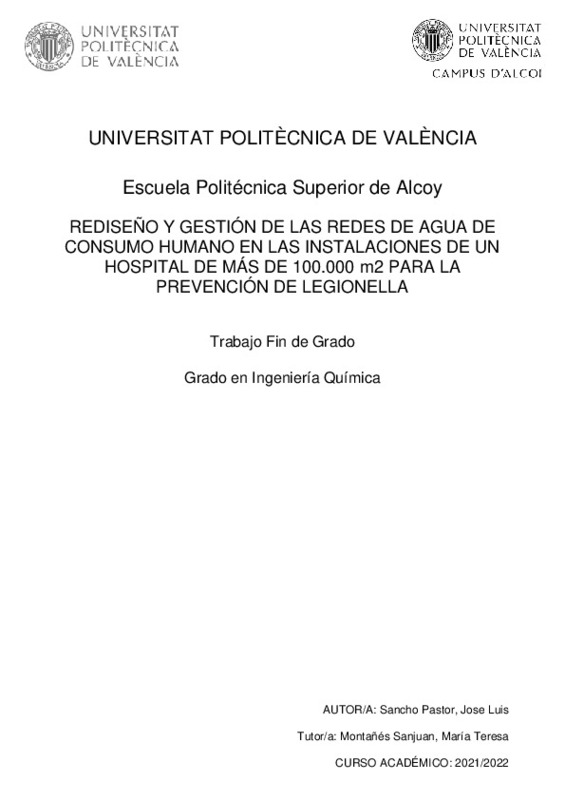|
Resumen:
|
[ES] Este Trabajo Fin de Grado pretende dar un paso más en el estudio y tratamiento de la Legionella en las instalaciones de distribución de Agua Sanitaria para Consumo Humano, profundizando en la parte de operatividad y ...[+]
[ES] Este Trabajo Fin de Grado pretende dar un paso más en el estudio y tratamiento de la Legionella en las instalaciones de distribución de Agua Sanitaria para Consumo Humano, profundizando en la parte de operatividad y herramientas para la gestión de las instalaciones de agua desde la fase de captación-producción hasta la entrega en punto terminal. El presente documento pretende ser la ampliación y
aplicación funcional de mi anterior TFM “Dispositivo para la prevención de Legionella en instalaciones de agua sanitaria”. en un hospital de más de 100.000 m2, buscando así la verificación técnico-económica del proyecto.
La motivación de este trabajo viene originada por una bacteria llamada Legionella y todas las acciones que se desencadenan para su prevención, mantenimiento de instalaciones y eliminación de ésta, adicionalmente a la
repercusión y consecuencias clínicas que tiene en las personas.
Durante los diferentes capítulos del documento se analizará la situación actual utilizando un punto de vista
diferente para encontrar una solución alternativa a las ya existentes en el mercado. No se pretende mejorar
las actuales, sino que el objetivo es promover un cambio de modelo: asegurar el resultado en el punto donde
se toman y analizan las muestras de agua, el punto terminal.
Por supuesto, esto no puede solucionarse cambiando sólo un eslabón de la cadena. El proyecto recorre todas
las fases necesarias para una inmersión en el tema. Va desde la captación-producción del agua e introducción
a las características de la Legionella, sigue con una propuesta para su control en el punto terminal junto con
unas propuestas y diseños que ofrezcan mejores resultados y desarrolla una propuesta de diseño funcional
del sistema de control basado en la normativa actual. Todo este conjunto aporta un valor añadido al
mantenedor y gestor de las instalaciones facilitando el control, su gestión, así como la optimización y ahorro
de múltiples recursos junto con la mejora en calidad percibida, seguridad y eliminación de molestias a los
usuarios.
En la parte final del trabajo se recoge mediante un estudio económico el impacto que tiene la automatización
y uso de tecnología aplicada en este sistema para el medio ambiente, el propio edificio, su cronograma de
implantación y el periodo previsto de amortización.
El conjunto de acciones expuestas en este proyecto ahonda en un nicho existente y evidente, por lo que, si en
algún aspecto no se consiguen alcanzar todas las expectativas deseadas, al menos se pretende exponer una
manera de pensar no comercial, que motive a cambiar la forma de hacer las cosas, así como exponer las ventajas que un sistema cerrado y automatizado puede dotar a la instalación de distribución, no existentes en
la actualidad.
[-]
[EN] This Final Degree Project aims to go a step further in the study and treatment of Legionella in the distribution
facilities of Sanitary Water for Human Consumption, deepening in the part of operability and tools for ...[+]
[EN] This Final Degree Project aims to go a step further in the study and treatment of Legionella in the distribution
facilities of Sanitary Water for Human Consumption, deepening in the part of operability and tools for the
management of water facilities from the catchment-production phase to the delivery at the terminal point.
The present document intends to be the extension and functional application of my previous TFM "Device for
the prevention of Legionella in sanitary water installations" in a hospital of more than 100,000 m2, looking for
the technical-economic verification of the project.
The motivation of this work is originated by a bacterium called Legionella and all the actions that are triggered
for its prevention, maintenance of facilities and its elimination, in addition to the repercussion and clinical
consequences that it has on people.
During the different chapters of the document, the current situation will be analyzed using a different point of
view to find an alternative solution to those already existing in the market. The aim is not to improve the
current ones, but to promote a change of model: to ensure the result at the point where the water samples
are taken and analyzed, the terminal point.
Of course, this cannot be solved by changing just one link in the chain. The project goes through all the phases
necessary for an immersion in the subject. It goes from water collection-production and introduction to the
characteristics of Legionella, continues with a proposal for its control at the terminal point together with
proposals and designs that offer better results and develops a proposal for the functional design of the
control system based on current regulations. All this provides an added value to the maintainer and manager
of the facilities, facilitating the control and management, as well as the optimization and saving of multiple
resources together with the improvement in perceived quality, safety and elimination of inconveniences to
the users
The final part of the work includes an economic study of the impact of automation and the use of technology
applied in this system on the environment, the building itself, its implementation schedule and the expected
payback period.
The set of actions presented in this project delves into an existing and evident niche, so that, if in some aspect
it is not possible to achieve all the desired expectations, at least it is intended to expose a non-commercial
way of thinking, which motivates to change the way of doing things, as well as to expose the advantages that
a closed and automated system can provide to the distribution installation, not existing at present.
[-]
|







